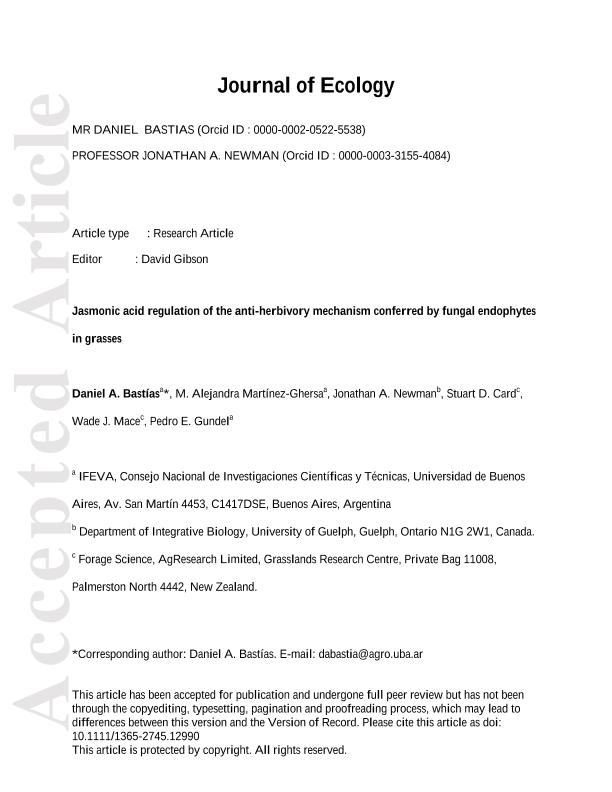Mostrar el registro sencillo del ítem
dc.contributor.author
Bastias Campos, Daniel

dc.contributor.author
Martinez-Ghersa, Maria Alejandra

dc.contributor.author
Newman, Jonathan A.
dc.contributor.author
Card, Stuart D.
dc.contributor.author
Mace, Wade J.
dc.contributor.author
Gundel, Pedro Emilio

dc.date.available
2019-11-13T18:50:12Z
dc.date.issued
2018-11
dc.identifier.citation
Bastias Campos, Daniel; Martinez-Ghersa, Maria Alejandra; Newman, Jonathan A.; Card, Stuart D.; Mace, Wade J.; et al.; Jasmonic acid regulation of the anti-herbivory mechanism conferred by fungal endophytes in grasses; Wiley Blackwell Publishing, Inc; Journal of Ecology; 106; 6; 11-2018; 2365-2379
dc.identifier.issn
0022-0477
dc.identifier.uri
http://hdl.handle.net/11336/88760
dc.description.abstract
The most studied mechanism of protection against herbivores in grasses associated with Epichloë fungal endophytes has been the fungal production of alkaloids. However, the contribution of the plant immune response on the level of resistance to herbivores in symbiotic grasses has been poorly explored. We studied the relationship between the plant hormone, jasmonic acid (JA) and Epichloë fungal endophytes on herbivore defences in symbiotic grasses. We hypothesized that an exogenous application of methyl jasmonate (MeJA), an activator of the plant JA defence response, would increase the level of resistance of endophyte-symbiotic and non-symbiotic plants to a chewing insect. As Epichloë endophytes produce alkaloids, an enhancement of the JA defence would complement the resistance given by these alkaloids. Lolium multiflorum plants symbiotic and non-symbiotic with the endophyte Epichloë occultans were subjected to an exogenous application of MeJA followed by a challenge with the generalist chewing insect Spodoptera frugiperda. We measured the level of plant resistance to chewing insects, and the defences conferred by host plants and fungal endophytes. Symbiotic plants were more resistant to S. frugiperda than their non-symbiotic counterparts. However, despite the fact that the concentration of JA significantly increased in all plants exposure to MeJA, neither endophyte-symbiotic nor non-symbiotic plants showed an enhanced resistance to insects. Unexpectedly, the exposure of endophyte-symbiotic plants to MeJA led to a reduction in the concentration of loline alkaloids (i.e. N-formyllolines and N-acetylnorlolines), consequently decreasing the level of plant resistance to the herbivore. Synthesis. Our results suggest that, rather than complementing the alkaloid-based defence, the jasmonic acid hormone weakens the anti-herbivore mechanism conferred by Epichloë endophytes. The present study highlights that the interaction between the jasmonic acid hormone and the presence of leaf fungal endophytes can be of importance for the effectiveness of the anti-herbivore defences of symbiotic plants.
dc.format
application/pdf
dc.language.iso
eng
dc.publisher
Wiley Blackwell Publishing, Inc

dc.rights
info:eu-repo/semantics/openAccess
dc.rights.uri
https://creativecommons.org/licenses/by-nc-sa/2.5/ar/
dc.subject
ALKALOIDS
dc.subject
BENEFICIAL MICRO-ORGANISMS
dc.subject
ENDOPHYTE SYMBIOSIS
dc.subject
EPICHLOË
dc.subject
JASMONATES
dc.subject
JASMONIC ACID
dc.subject
PLANT DEFENCES
dc.subject.classification
Agricultura

dc.subject.classification
Agricultura, Silvicultura y Pesca

dc.subject.classification
CIENCIAS AGRÍCOLAS

dc.title
Jasmonic acid regulation of the anti-herbivory mechanism conferred by fungal endophytes in grasses
dc.type
info:eu-repo/semantics/article
dc.type
info:ar-repo/semantics/artículo
dc.type
info:eu-repo/semantics/publishedVersion
dc.date.updated
2019-10-23T21:13:46Z
dc.journal.volume
106
dc.journal.number
6
dc.journal.pagination
2365-2379
dc.journal.pais
Reino Unido

dc.journal.ciudad
Londres
dc.description.fil
Fil: Bastias Campos, Daniel. Consejo Nacional de Investigaciones Científicas y Técnicas. Oficina de Coordinación Administrativa Parque Centenario. Instituto de Investigaciones Fisiológicas y Ecológicas Vinculadas a la Agricultura. Universidad de Buenos Aires. Facultad de Agronomía. Instituto de Investigaciones Fisiológicas y Ecológicas Vinculadas a la Agricultura; Argentina
dc.description.fil
Fil: Martinez-Ghersa, Maria Alejandra. Consejo Nacional de Investigaciones Científicas y Técnicas. Oficina de Coordinación Administrativa Parque Centenario. Instituto de Investigaciones Fisiológicas y Ecológicas Vinculadas a la Agricultura. Universidad de Buenos Aires. Facultad de Agronomía. Instituto de Investigaciones Fisiológicas y Ecológicas Vinculadas a la Agricultura; Argentina
dc.description.fil
Fil: Newman, Jonathan A.. University of Guelph; Canadá
dc.description.fil
Fil: Card, Stuart D.. AgResearch; Nueva Zelanda
dc.description.fil
Fil: Mace, Wade J.. AgResearch; Nueva Zelanda
dc.description.fil
Fil: Gundel, Pedro Emilio. Consejo Nacional de Investigaciones Científicas y Técnicas. Oficina de Coordinación Administrativa Parque Centenario. Instituto de Investigaciones Fisiológicas y Ecológicas Vinculadas a la Agricultura. Universidad de Buenos Aires. Facultad de Agronomía. Instituto de Investigaciones Fisiológicas y Ecológicas Vinculadas a la Agricultura; Argentina
dc.journal.title
Journal of Ecology

dc.relation.alternativeid
info:eu-repo/semantics/altIdentifier/doi/https://doi.org/10.1111/1365-2745.12990
dc.relation.alternativeid
info:eu-repo/semantics/altIdentifier/url/https://besjournals.onlinelibrary.wiley.com/doi/abs/10.1111/1365-2745.12990
Archivos asociados
